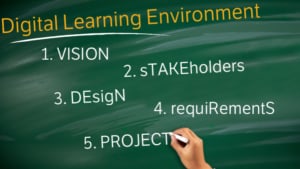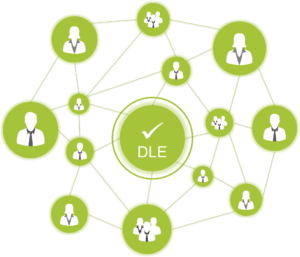Sometime ago, I ran into a quote about learning that sticks into my mind. There are a lot of quotes hunting the social media networks, but this one just didn't want to go away. It was the starting point of a reflection on how to create a great learning experience for today's learners. I end up with five simple but essential steps that I will share with you in a series of posts. We will start today with a short overview of these steps.

This quote from Albert Einstein resonates to me like the perfect antithesis to most of the Learning Management Systems that I've seen up to now. In terms of technology and functionalities they are perfect, but there is no experience, no emotion when you use them. They deliver the exact opposite of what learners expect: they deliver just information.

But how can we deliver an experience through a Learning Management System?
Your LMS is more than a simple tool, it's an environment. For your learners it is their Learning Environment. Think of this environment from their perspective: how they learn, what they expect, how they interact with this environment. These type of questions can open endless opportunities to improve their digital learning experience. Below you can find 5 simple steps that will guide you in this new journey.
Step 1 : Create the vision
Before thinking of what your produ
our choices being for the prioritization of the features, tools to integrate as part of your solution or partners you would like to have building this solution for you.
Step 2: Identify your stakeholders and understand them

Stakeholders
Your stakeholders do not restrain themselves to your learners. Anyone that will have an impact on your environment or is going to be interact directly or indirectly with it, has to be considered. Any of the stakeholder can bring a different piece for your solution: a need or a constraint. Get to know them, understand what are their hopes, pains and influence. Knowing as many as you can, helps you have a complete overview of how your solution could best satisfy them.
Step 3: Design their experience
The experience your learner will have using your solution will be key for its adoption and ultimately its success. Beyond the learning material, assignments and any other feature your solution will bring, the design is the part that can bring emotion and facilitate the learning process. “Small” things like the colors, the font, the amount of information display at once or intuitive structure can change everything. Intuitive and smooth use can move your learner mindset from “another ugly and technical tool that we have to use” to “amazing learning experience”.
Step 4: Formulate your requirements
At this point you have two important pieces of the final puzzle: the needs and constrains your solution have to satisfy and the way your solution can satisfy them. In order to get things done, you need to formulate all of them into requirements.
A requirement captures a comprehensible representation of a need or a constraint. You can for example use User Stories to formulate your stakeholders needs and constraints into requirements.
Step 5: Define your project
You have to start your project before the project starts. Hum… that's a strange statement… In fact, not so strange. Before starting building up a team and start working on your project, you need to properly define it. Why? So that: the sponsor supports you, the project team understand want needs to be done and the users know that to expect at the end.
The sponsor may have a budget that can cover only partially everything you imaged during the four first steps, so you need to prioritize.
Needs and requirements may change, so you need to know how you want to handle it. Little hint over here: Agile Requirement Management and development could help you.
To conclude
These five steps may seem simple but they are essential. At the start of a project, you should always take the time to carefully define what you want to achieve. It order to support you in the definition of your perfect digital learning environment, I will provide an in-depths explanation of each steps.

